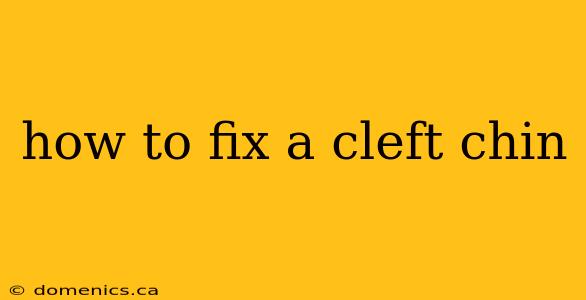A cleft chin, also known as a chin cleft or a chin dimple, is a naturally occurring indentation in the chin. While some people embrace their cleft chin as a unique feature, others may wish to minimize its appearance or completely alter its look. This article explores various options for addressing a cleft chin, from non-surgical methods to more invasive procedures. Understanding the available choices empowers you to make an informed decision that best aligns with your aesthetic goals.
Understanding Cleft Chins
Before diving into treatment options, it's important to understand what causes a cleft chin. Genetically determined, this feature results from a variation in the fusion of the two halves of the mandible (jawbone) during fetal development. The depth and prominence of the cleft can vary significantly. Some individuals have a barely noticeable dimple, while others have a more pronounced indentation.
Non-Surgical Options for Minimizing a Cleft Chin
Several non-invasive techniques can help reduce the appearance of a cleft chin, though they won't eliminate it entirely:
1. Makeup Techniques
Strategic application of makeup can effectively camouflage a cleft chin. Contouring and highlighting techniques can create the illusion of a smoother chin line.
- Contouring: Apply a darker shade of foundation or concealer to the indentation. This creates shadows that visually minimize the cleft.
- Highlighting: Use a lighter shade on the surrounding areas to draw attention away from the cleft. Blend seamlessly for a natural look.
Many online tutorials demonstrate these techniques. Experiment to find the most flattering approach for your facial structure.
2. Hairstyle Choices
Certain hairstyles can also subtly minimize the appearance of a cleft chin. For instance:
- Longer hairstyles: Hair that frames the face can help to soften the chin's appearance and draw the eye upwards.
- Strategic layering: Carefully layered hairstyles can add volume and balance to the face, further diminishing the prominence of the cleft.
Consult with a stylist to explore options that best complement your face shape and hair texture.
Surgical Options for Cleft Chin Correction
For individuals seeking a more significant change, surgical intervention offers a more permanent solution. These procedures typically require consultation with a plastic surgeon:
1. Chin Augmentation
Chin augmentation is a surgical procedure that involves adding volume to the chin to reduce the prominence of the cleft. This is often accomplished through the use of implants or fillers:
- Implants: These are permanent solutions that add substantial volume. Selection of the implant size and type is crucial.
- Fillers: These provide a less permanent solution. While they can smooth out the cleft, they may require periodic re-injections.
The recovery time and potential risks associated with these procedures vary. Thorough discussion with a surgeon is essential to weigh the benefits against potential risks.
2. Genioplasty
Genioplasty is a more complex surgical procedure involving reshaping the chin bone itself. This is typically reserved for cases where the cleft is significantly pronounced or other jawline irregularities exist.
- Bone reshaping: This can involve shaving down the bone to achieve a more uniform chin shape.
- Bone grafting: In some cases, bone may need to be added to correct irregularities.
The recovery process for genioplasty is longer and more involved than chin augmentation.
Choosing the Right Procedure
The ideal procedure will depend on several factors, including:
- The severity of the cleft: A subtle cleft may be effectively addressed with non-surgical methods. A more pronounced cleft might require surgery.
- Personal preferences: Some individuals prefer a less invasive approach, while others seek a more dramatic and permanent change.
- Overall facial harmony: A skilled surgeon will consider the overall balance of your facial features when planning any procedure.
Remember to research and choose a board-certified plastic surgeon with extensive experience in chin augmentation and genioplasty.
Post-Procedure Care and Expectations
Regardless of the chosen method, proper aftercare is crucial for optimal results. Your surgeon will provide detailed instructions tailored to your specific procedure. Generally, this may include:
- Medication: Pain relievers and antibiotics might be prescribed to manage discomfort and prevent infection.
- Swelling management: Ice packs and elevation can help minimize swelling.
- Activity restrictions: Avoid strenuous activities for a period of time.
Realistic expectations are key. While surgical procedures can significantly improve the appearance of a cleft chin, perfect symmetry is rarely achievable. Open communication with your surgeon throughout the process is crucial.
Conclusion
Fixing a cleft chin is a personal decision. Whether you opt for a non-surgical approach or undergo surgery, ensuring you’re fully informed and working with a skilled professional is critical. Weigh the pros and cons of each option carefully to choose the method that best suits your needs and expectations. Remember, ultimately the goal is to enhance your self-confidence and feel good about your appearance.
